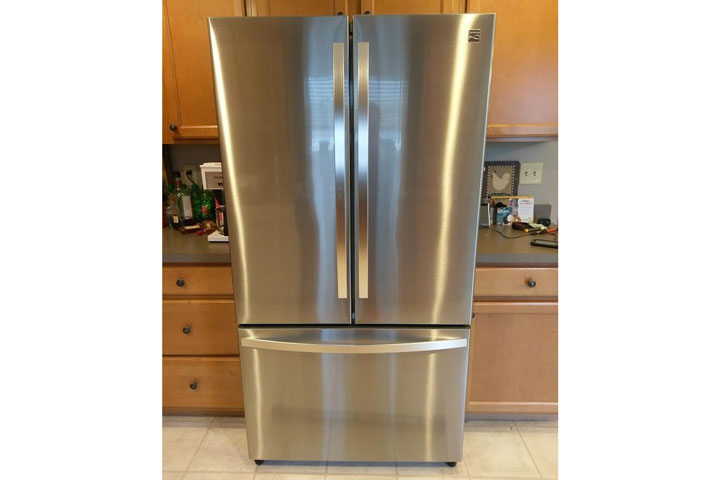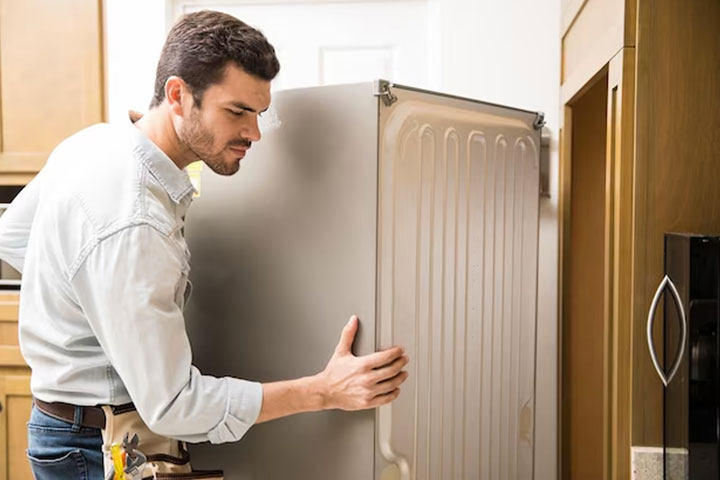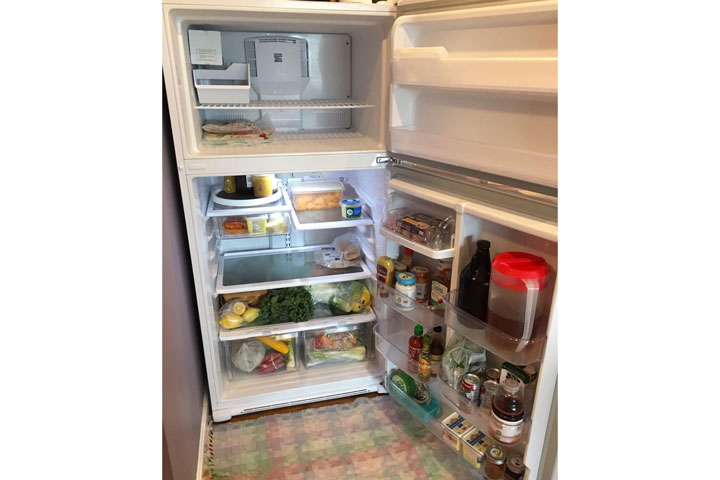If your Kenmore refrigerator not cooling, it can be a frustrating and potentially costly problem. Fortunately, there are several possible causes for this issue that you can check before calling a repair technician.
One possible cause of a Kenmore refrigerator not cooling is dirty coils. Over time, the condenser coils on the back or bottom of your fridge can become coated with dust and debris, hindering their ability to release heat.
In this article, we will explore some common reasons why your Kenmore refrigerator may not be cooling properly and what steps you can take to address them. Check also samsung ice maker not working!
Common Problems on Kenmore Refrigerator Not Cooling

Your Kenmore refrigerator not cooling? It could be something simple – or serious. Knowing the model helps troubleshoot.
Check for trouble codes on the display panel – they can indicate a potential malfunction.
Any error codes can guide you in determining what needs attention. They can also help you find technical information for repair procedures. Here are common problem causing Kenmore Refrigerator Not Cooling.
1. Dirty Condenser Coils
The condenser coils are located at the back of the fridge and play a crucial role in releasing heat from the refrigerant. When they become clogged with dust, dirt or pet hair, they cannot perform efficiently leading to poor cooling.
As a result, your fridge may start making strange noises or emit warm air from its vents instead of cool air.
2. Faulty Evaporator Fan
The evaporator fan plays a crucial role in the cooling process by circulating cool air throughout the fridge. When it malfunctions, the fridge can’t maintain its temperature and your food may spoil.
If you suspect that your Kenmore refrigerator is not cooling due to a faulty evaporator fan, there are some simple steps you can take to confirm this diagnosis.
First, unplug the fridge and remove any items that may be blocking access to the fan. You’ll likely find it located in the freezer compartment behind a panel or cover.
3. Malfunctioning Thermostat
If your Kenmore refrigerator is not cooling, the culprit might be a malfunctioning thermostat. The thermostat regulates the temperature in your fridge and freezer compartments.
It controls when the compressor turns on and off to keep everything at the right temperature. If it’s not working correctly, your fridge may run constantly or fail to cool adequately.
One of the first signs that there’s a problem with your Kenmore refrigerator’s thermostat is if you notice that it feels too warm inside.
Another sign is if food starts spoiling faster than usual, even if you’ve set the temperature according to manufacturer recommendations. You might also notice frost buildup on items in your freezer, which can indicate that cold air isn’t circulating properly through the unit.
4. Defective Start Relay
A start relay is an electrical component that helps your refrigerator compressor kick-start and run efficiently. If the start relay fails or malfunctions, your fridge won’t cool properly, which can be frustrating.
One of the symptoms of a bad start relay is when you hear clicking sounds coming from behind your fridge. Another telltale sign is if your compressor runs for a few seconds before shutting off again without cooling anything inside the fridge.
5. Low Refrigerant Level
Refrigerant is the liquid that flows through your refrigerator coils and absorbs heat from inside the fridge, keeping it cool. Without enough refrigerant, your fridge cannot operate efficiently.
One sign that you have low refrigerant in your Kenmore refrigerator is if the compressor sounds like it’s running constantly but doesn’t produce cold air.
Another clue might be if the coils feel warm to the touch instead of cool. Additionally, if you see frost buildup on your freezer walls or notice water leaking from underneath your appliance, these may also be symptoms of a low refrigerant level.
How to Fix Kenmore Refrigerator Not Cooling

Unplug your Kenmore refrigerator before attempting any repairs. Check the temperature settings. Here are some tips on how to fix Kenmore Refrigerator Not Cooling:
1. Clean the Condenser Coils
To fix this problem, you need to clean the condenser coils of your Kenmore refrigerator. Start by unplugging the appliance and locating the coils. Depending on the model of your fridge, you may find these coils behind a panel at the back or bottom of the unit.
Use a vacuum cleaner with a brush attachment to remove any loose debris from around the area before proceeding with cleaning.
Next, use a coil cleaning brush or soft-bristled paintbrush to gently remove any remaining dirt or dust from each coil.
2. Check the Evaporator Fan
To begin, locate the evaporator fan in your Kenmore refrigerator. It’s usually located in the freezer behind an access panel or inside a vented cover on the back of your fridge.
Once you’ve found it, unplug your fridge and remove any food or shelves blocking access to it. Use a screwdriver or socket wrench to remove any screws holding the cover in place.
Next, inspect your evaporator fan for damage or blockages.
3. Test the Thermostat
To test the thermostat, first unplug your refrigerator from its power source. Locate the thermostat control panel on the top or bottom of your fridge and remove it using a screwdriver. Inspect for damage or corrosion on the wires and terminals connected to the thermostat.
Next, use a multimeter to test if there’s continuity between each terminal when you turn down or up the temperature control knob.
If there’s no continuity when you turn up or down the knob, then that means your thermostat is faulty and needs replacement. In this case, contact a professional technician to install a new one for you.
4. Check the Start Relay
To fix a faulty start relay, you’ll need to first unplug your refrigerator and remove any covers or panels that are blocking access to the part.
Once you’ve located the start relay (it’s usually located near the compressor), use a multimeter or continuity tester to test its functionality. If there’s no continuity or resistance when testing, then it’s likely time for a replacement part.
You can order a new start relay online or through an appliance repair shop and install it yourself following manufacturer instructions or consult a professional if unsure.
5. Refill the Refrigerant
First, turn off your refrigerator and unplug it from the power source. Locate the access valve on your fridge – this will typically be on the back or side of the unit. Use a wrench to remove the cap from this valve carefully.
Next, attach a refrigerant gauge to the valve and check its current level. If it’s low, you’ll need to add more refrigerant – make sure you use only a type that matches what’s already in your fridge.
Why my Kenmore refrigerator not cooling but freezer works?

It could be from issues with the evaporator fan motor, condenser fan motor, defrost timer, or thermostat.
The evaporator fan moves cold air from freezer to fresh food section. If it’s not working, it may hum but no air will circulate.
The condenser fan cools both compartments. If it’s not working, the refrigerator won’t cool.
The defrost timer regulates little refrigerant tubes to melt frost. If this isn’t done, circulation of cold air is blocked.
Lastly, a malfunctioning thermostat hinders cooling of both compartments. Maybe check icemaker line or door gasket issues too.
Fixing Kenmore refrigerator fan not working
Faulty fans may cause other issues, for example frost or ice buildup or poor cooling.
Use a multimeter to inspect damage. If no current is getting to the fan because it’s not spinning properly, attempt to repair it. Double check all connection points to make sure they are in place. Re-plugging them can help the electrical flow. If the fan still doesn’t work, replace it with a new motor part.
Maybe the evaporator fans are the problem. Before replacing the component, verify if other factors are causing the issue. For example, a defective controller module or an incorrectly installed condenser unit. Adjustments can fix these problems, saving time and money. In some cases, you may need professional help.
Why Kenmore French Door Refrigerator Not Cooling?
A Kenmore French door fridge has two sections which both chill. In the upper right-hand corner there’s a temp control section. If cooling is not happening, troubleshoot to find the cause. Here are the common causes:
- Thermostat issues. This can be caused by a power surge or internal wiring fault leading to it turning off.
- Compressor problems. Not enough refrigerant or clogged vents blocking air flow in the condenser coils.
- Deteriorating door seals. Air leakage leads to higher temps, making it less efficient.
To keep your fridge in shape, periodically clean it with warm water and vinegar. Check the gaskets on the door seals for wear and tear.
Never DIY repairs without unplugging it first. Ask help from qualified professionals for drastic measures like replacing thermostat parts or compressor bits.
Fixing Kenmore French Door Refrigerator Not cooling
Unplug or turn off your Kenmore refrigerator. Clean any dust or debris from its parts.
Check the temperature control panel. Ensure nothing is blocking the air vents. Make sure the seals are secure. Check for frost buildup in the freezer.
If these steps don’t work, you may need to call a service technician or replace the faulty parts/refrigerator.
Why Kenmore refrigerator leak water?
Kenmore refrigerators may stop cooling and begin to leak if the condensate lines are clogged with ice or debris.
Condensate lines are small tubes that collect condensed water during the cooling cycle. If these are blocked, the condensation can’t escape and builds up in the fridge – resulting in a leak from underneath or from behind the back panel.
How to Fix:
Before trying to fix, be sure the power cord is securely plugged into a working outlet. If not, the refrigerator won’t cool and there may be signs of moisture.
Next, check your condensate line for blockages. Ice can quickly form inside, preventing it from draining. To check this area, remove both ends of the line (located at the back of the fridge) and look for blockages inside – flush away debris with warm water until it’s clear. If no large chunks are found, unclogging chemical solutions may help clear tough blockages safely.
Is there a reset button on a Kenmore refrigerator?
Kenmore refrigerator models differ in features, so not all come with a reset button. If your Kenmore fridge is displaying an E1 code or other error codes, try a factory reset. This may help.
A factory reset will erase settings like personal temperature levels, and it will restore your Kenmore fridge to default settings. To do this, locate the control panel inside the fridge, press and hold the “Energy Saver” button for 15 seconds until you hear a beep. After, you’ll need to adjust the temperature setting and close the door. Depending on the model, you may need to reboot the ice maker. Refer to your user manual for details.
How can you tell if refrigerator compressor is not working?
Check if it turns on and runs. Listen – it should not make any loud noises or vibrate much. If you hear buzzing, something is wrong.
Check the current at the fridge’s base. Use a circuit tester or multimeter. If no current flows, there may be wiring or power supply issues. Or maybe the fridge’s circuitry!
Finally, check the fridge parts like fan motors, condensers coils and evaporators. See if anything needs addressing before attempting a repair or replacing parts like the compressor.
What is the most common cause of refrigerator compressor failure?
Reasons for compressor failure include: inadequate lubrication, overloading the system with too much refrigerant, using wrong refrigerants, improper installation and temp-control problems. Poor airflow or blocked heat exchangers can also cause failure if not fixed quickly.
To keep your Kenmore refrigerator working for years, have its components checked and maintained according to manufacturer guidelines.
What damages fridge compressor?
Excessive heat can make the compressor take in too much electricity and overheat. Overloading happens when the fridge is trying to cool down too much stuff or when there’s a blockage in the refrig line that stops airflow. Clogged lines occur from improper maintenance, which lets particles from the evaporator gather and block the air.
With good care and maintenance, most compressors last for a long time without any big issues.
“There is no real ending. It’s just the place where you stop the story.”






